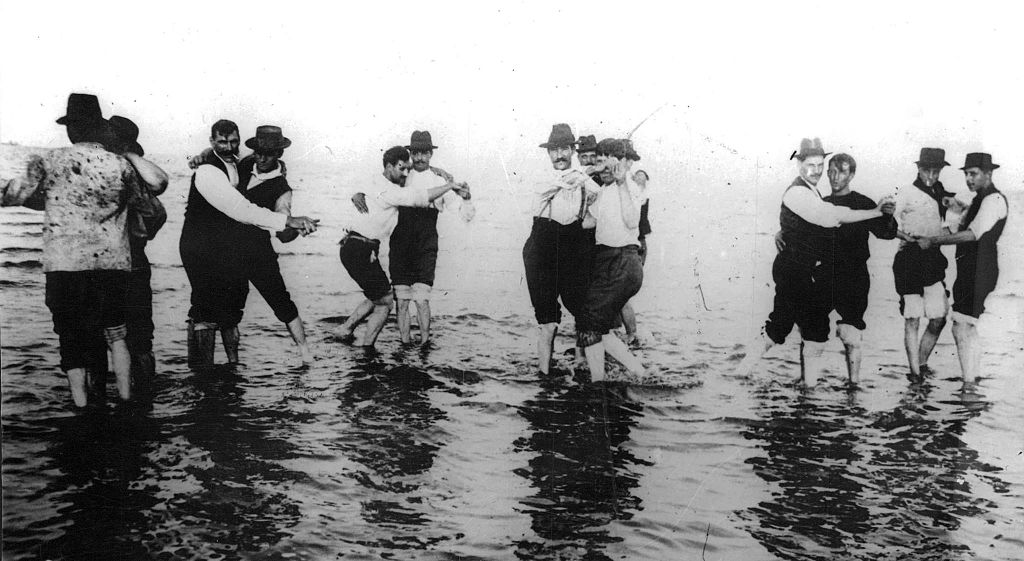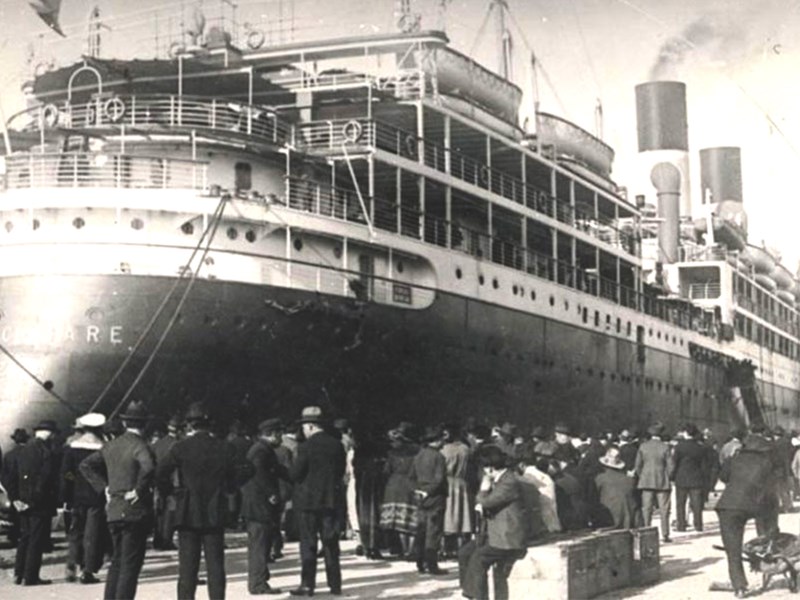Tango Trails & Spanish Tales
Discover Argentine culture & Spanish tips!
Tango Immigration Roots
from Spain, Italy, Africa, Poland, and other parts of Europe.

¡Hola, futuros milongueros y exploradores de almas!
Have you ever noticed how, here in Argentina, almost every conversation about family eventually circles back to los abuelos (the grandparents)? “My nonno was from Calabria,” “My abuela came from Galicia,” “My great-grandparents arrived from Poland.” It’s not just small talk; it’s a profound connection to the massive wave of inmigrantes (immigrants) who shaped not just our families, but the very soul of Argentine culture, and especially, our beloved Tango.
Forget the superficial stereotypes for a moment. To truly grasp Tango, you need to understand the human tide that flowed into these ciudades puerto (port cities) of Buenos Aires and Montevideo. That’s where the sentimiento of Tango truly began to brew.
Here at TangoSpanish, we believe understanding this rich tapestry makes your Spanish learning journey infinitely more fascinating, and your tango steps imbued with deeper sentimiento (feeling).
In fact, many Argentines still today carry stories in their blood, stories of abuelos (grandparents) and bisabuelos (great-grandparents) who made an incredible journey. Like many of our teachers, many grew up hearing tales of “la nonna” from Italy or “el abuelo” from Spain or “el zeide” y “la bobe“ from Poland, and these stories are part of our shared Argentine identity.
We believe understanding this rich tapestry makes your Spanish learning journey infinitely more fascinating, and your tango steps imbued with deeper sentimiento (feeling).

The Human Tide: Buenos Aires, The Great Welcome
Imagine late 1800s to early 1900s. Buenos Aires wasn’t the sprawling metropolis we know today; it was transitioning from a “gran aldea” (large village) of less than 200,000 people in 1870 to one of the world’s largest cities by 1914, bursting with over 1.5 million souls!
This incredible growth was fueled by hundreds of thousands of immigrant workers, mostly men, arriving from countless nations – Spain, Italy, Poland, Russia, and many others.
They came, leaving behind war-torn lands and poverty, filled with dreams of a better life. This wasn’t just a simple journey; it was a romería (a bustling pilgrimage), a one-way ticket for many. These new arrivals, often lonely and overwhelmed by nostalgia (longing for home), mixed with the local populations – a vibrant blend of Spanish colonizers, indigenous peoples, and African descendants. It was an unprecedented, multi-ethnic, and multicultural interaction, almost unparalleled anywhere in the world at the time.
Tango’s Cradle: Born of Longing and Lunfardo
It was in this unique crisol de razas (melting pot) – between the mid-1890s and late 1910s – that Tango rioplatense truly emerged. It shed its earlier, simpler forms (like the old milonga music) and developed its own distinct personality.
Think of those early Tango tunes:
“El Entrerriano” and “Don Juan”: These were pioneers, setting the three-part structure that defined the early Tangos.
Ángel Villoldo: A genius composer, he penned classics like “El Choclo” (often called the “King of Tangos”) and “La Morocha” – some of the first Tangos to feature actual letras (lyrics)!
Orquestas Típicas Criollas: Bands like those of Vicente Greco and Juan Maglio (known as “Pacho”) set the stage.
The Bandoneón: And then, towards the end of this foundational period, came the German bandoneón. Its melancholic, expressive sound perfectly captured the soul of this new music, solidifying Tango as we know it.
These songs weren’t always about passionate love; they often spoke of the hardships, the desencuentro (missed encounters or misunderstandings) on crowded streets, the yearning for a distant homeland, and the raw emotions of life in the arrabal (poor city outskirts).
The Immigrant’s Odyssey: A Story of Grit and Determination
Why did millions chose expatriarse (expatriate themselves)?
It was a complex mix of harsh conditions in their homelands (poverty, lack of prospects) and the pull of Argentina, which, after 1880, offered political stability, economic growth, and government incentives to attract European workers.
The peak of immigration occurred between 1895 and 1914, a period in which immigration was directly related to colonization and, when this was not possible, to agricultural work.
The journey itself was no small feat. From their humble villages, they traveled by train to bustling European ports (Genoa, Naples, Hamburg), then boarded massive vapores (steamships). While these new ships were faster and cheaper than old sailing vessels, the conditions for third-class passengers were often harrowing: hacinamiento (overcrowding), poor hygiene, and inadequate food. As writer Edmundo De Amicis dramatically recounted, it was a “nightmare of crowds, bad smells, excessive cold or heat, and intolerable promiscuity.” Yet, they endured, driven by hope and the promise of a new life.
“Decálogo para los inmigrantes que viajaban a la Argentina”. Manual del inmigrante, difundido por las compañías de inmigración en Italia en 1902.
- Cuando una banda toca el Himno Nacional, todos los presentes se descubren la cabeza en señal de reverencia.
- A cualquier mujer, sea una dama o una lavandera, se le dice habitualmente “señora“. Llamar a una “donna” del pueblo “mujer”, no suena bien, ya que equivale a decir “hembra“.
- Para llamar a la gente en la entrada de la casa, no se golpea ni se grita; se baten las palmas de las manos.
- Para llamar a un carruaje o para avisar desde lejos al conductor de un tranvía para que pare, no se dice “pss, pss, pss, sino “psiiió, psiiió”.
- En los cafés hay siempre un lugar especial para las señoras. Son admitidos sólo los hombres que las acompañan.
- En un café o en un restaurant se llama al camarero batiendo las palmas dos veces y agregando inmediatamente la llamada de “mozo”. No se golpea sobre la mesa el vaso.
- En la platea de los teatros y cines, no está permitido, ni siquiera a las mujeres, llevar el sombrero puesto, ya que se impediría a los otros ver la escena.
- No se fuma ni en los tranvías. El aviso “Esta prohibido salivar”, significa “vetato sputare”…
- Por la calle no se camina fuera de la vereda; de hacerlo, recibiría el calificativo de “atorrante”, que equivale a “mendigo”.
“Decalogue for Immigrants Traveling to Argentina.” Immigrant’s Manual, distributed by immigration companies in Italy in 1902.
- When a band plays the National Anthem, all those present uncover their heads in a sign of reverence.
- Any woman, whether a lady or a laundress, is usually addressed as “madam.” Calling a “donna” (sic. in Italian) of the people “woman” does not sound right, as it is equivalent to saying “female.”
- When calling people at the entrance of a house, one does not knock or shout; one claps one’s hands.
- To call a carriage or to signal a streetcar driver from a distance to stop, you don’t say “psh, psh, psh,” but rather “psiiió, psiiió.”
- In cafés, there is always a special place for ladies. Only men accompanying them are admitted.
- In a café or restaurant, the waiter is called by clapping his hands twice and immediately adding the call “waiter.” One does not bang one’s glass on the table.
- In the theater and cinema stalls, it is forbidden, not even for women, to wear hats, as it would obscure others’ view of the scene.
- Smoking is prohibited, even on streetcars. The warning “It is forbidden to spit” means “vetato sputare” (to spit).
- One does not walk outside the sidewalk; doing so would earn one the epithet “loitering,” which is equivalent to “beggar.”
Which Countries did the Most Emigrants Depart From?
The majority of immigrants who moved to Argentina historically came from European countries, particularly Italy and Spain. During the great immigration wave between 1870 and 1914, the three most represented countries of origin were Italy, Spain, and France, with immigrants from these countries accounting for over 5 million people.
Nowadays, almost 40% of Argentineans are at least partially of Italian descent, and almost the same number of Spanish descent. And it is estimated that between 1890 and 1945, 30% of the population of the country had been born abroad, a figure that is estimated to reach 70% in the city of Buenos Aires.
Imagine how the culture of a city was completely reshaped with 70% of foreigners! Linguists have studied that the intonation of the Spanish spoken in Buenos Aires is actually closer to the Italian spoken in Naples than to any other regional variant of Spanish!
Our Roots Run Deep: The Enduring Legacy
Today, centuries later, those raíces (roots) are still incredibly strong. It’s why virtually every Argentine family has a story about a courageous grandparent or great-grandparent who crossed the ocean, carrying dreams and often very little else. This shared herencia (heritage) of diverse origins (be it Italian, Spanish, German, Polish, or many others) is deeply woven into the fabric of what it means to be Argentine. It’s in our accents, our food, our customs, and certainly, in our Tango.
Tango is the a living testament to the courage, sorrows, and hopes of those who arrived here. It’s the sentimiento of a nation forged from a global mestizaje (mixing of races/cultures).
At TangoSpanish, when we teach you Argentine Spanish, we’re not just giving you grammar rules. We’re opening a door to these profound stories, letting you feel the passion, the history, and the longing that gave birth to Tango. Learning the language is how you truly connect with this incredible cultural treasure, how you understand the whispers of the bandoneón and the tales hidden within every lyric.
#TangoSpanish #Immigration #ArgentineCulture #LearnSpanish #BuenosAires #TangoHistory #Bandoneon #Milonga #SpanishVocabulary #Heritage #ArgentineRoots
Are you ready to discover the immigrant soul of Tango?
Here’s why TangoSpanish one-on-one Spanish classes stand out:
🎯 Customized Lessons means tailored to your skill level, interests, and learning goals.
🔍 Cultural Insights means you will be learning Spanish through the lens of Argentine culture, tango history, and music.
🗓️ Flexible Scheduling classes are designed to fit your busy lifestyle.
🤓 Interactive Learning with engaging conversations and activities that make our Spanish learning process interesting, fun, and effective.
Ready to combine your love for music with language learning?
At TangoSpanish, we make learning Spanish an unforgettable experience. Whether you’re a beginner or looking to refine your skills, our one-on-one Spanish classes will help you achieve fluency while exploring the enchanting world of tango.
Book your first class today 50% off and discover how tango lyrics can transform your Spanish learning journey!
#ArgentineCulture #LearnSpanishArgentina #TangoSpanish #BuenosAiresCulture #WhatIsArgentineCulture #SpanishLanguage #CulturalImmersion #Asado #Mate #Lunfardo #RioplatenseSpanish